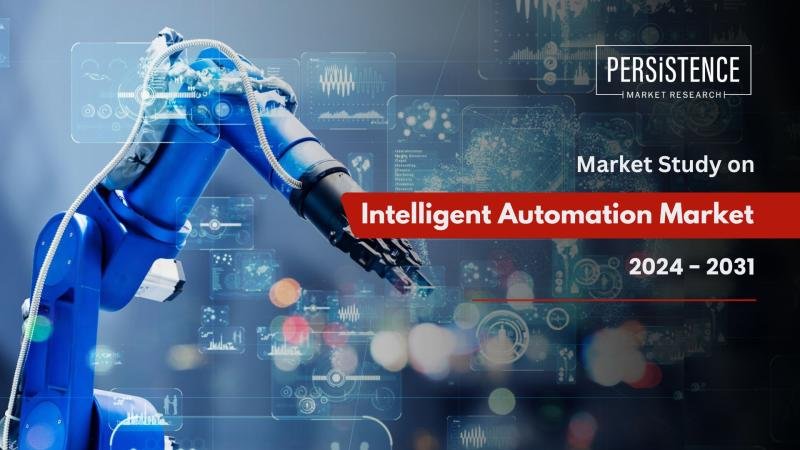The intelligent automation (IA) market is rapidly evolving as businesses across various industries strive to improve operational efficiency, reduce human error, and enhance customer experiences. Intelligent automation integrates artificial intelligence (AI), machine learning (ML), robotic process automation (RPA), and cognitive technologies to automate tasks traditionally performed by humans. This combination of automation and intelligence is driving significant advancements in industries ranging from manufacturing to retail and healthcare. The market is projected to experience substantial growth over the next decade, fueled by technological advancements and increasing demand for efficient operational solutions.
Market statistics show that the intelligent automation market is expected to grow at a compound annual growth rate (CAGR) of over 20% from 2024 to 2032. The increasing adoption of automation technologies in large enterprises, along with the proliferation of AI and machine learning capabilities, are key growth drivers. Manufacturing, automotive, and retail industries are particularly leading the charge in embracing intelligent automation due to the need for streamlined operations and enhanced customer interaction. North America is currently the leading geographical region for the IA market, driven by technological advancements, a strong presence of key players, and a favorable business environment for innovation.
Get a Sample PDF Brochure of the Report (Use Corporate Email ID for a Quick Response): www.persistencemarketresearch.com/samples/24508
Key Highlights from the Report
• Large enterprises are the primary adopters of intelligent automation, owing to the scalability and efficiency benefits it provides.
• Manufacturing and automotive sectors are leading industries in the adoption of intelligent automation technologies.
• North America is the dominant region in the intelligent automation market due to strong technological infrastructure.
• The software segment holds the largest share in the intelligent automation market, driven by increasing demand for AI and ML-driven solutions.
• The market is highly competitive, with major players including UiPath, and IBM.
Market Segmentation
The intelligent automation market can be segmented based on various factors, including enterprise size, industry, and component. By enterprise size, the market is divided into large enterprises and small to medium-sized enterprises (SMEs). Large enterprises are the primary adopters of intelligent automation, as they often have complex processes and larger operations that benefit the most from automation. SMEs, on the other hand, are gradually embracing these technologies as they become more affordable and accessible.
In terms of industry, the intelligent automation market spans several verticals. The automotive, manufacturing, and retail sectors are some of the largest adopters due to their high-volume, repetitive processes that can be automated for better efficiency. Other industries like pharmaceuticals, banking, financial services, and insurance (BFSI), and electronics are also experiencing significant growth in IA adoption. By component, the market is primarily segmented into software and services. Software solutions dominate the market, as businesses increasingly seek AI-driven automation tools to optimize their operations. Services, including consulting and system integration, also play a crucial role in helping businesses implement and maintain these technologies.
Regional Insights
North America remains the dominant region in the intelligent automation market, owing to its technological leadership and the presence of key industry players like IBM, and UiPath. The region’s established infrastructure, high levels of digitalization, and rapid adoption of AI technologies have made it a hub for innovation. Additionally, businesses in North America are increasingly recognizing the need to automate operations to stay competitive in the global marketplace.
Asia-Pacific (APAC) is another region experiencing rapid growth in intelligent automation adoption. Countries like China, Japan, and India are increasingly investing in digital transformation initiatives, which includes the implementation of intelligent automation technologies. APAC is expected to witness the fastest growth in the coming years due to rising industrialization, the proliferation of smart manufacturing, and a growing emphasis on cost optimization.
Market Drivers
The intelligent automation market is experiencing rapid growth due to several key drivers. First, businesses are under pressure to improve operational efficiency and reduce costs. Intelligent automation technologies help organizations achieve these goals by automating repetitive tasks, minimizing human error, and increasing speed and accuracy. Second, the rise of AI and machine learning capabilities has made intelligent automation more accessible and effective, enabling businesses to tackle more complex processes.
Another driver is the increasing demand for personalized customer experiences. In sectors like retail and e-commerce, intelligent automation is used to streamline customer service operations, provide personalized recommendations, and improve overall customer engagement. Finally, the need for enhanced compliance and security is driving the adoption of intelligent automation, particularly in the BFSI and healthcare industries, where regulations are stringent and data security is critical.
Market Restraints
Despite its potential, the intelligent automation market faces several challenges. One major restraint is the high initial cost of implementation. While intelligent automation promises significant long-term benefits, the upfront investment in AI-driven solutions, software, and infrastructure can be a barrier for smaller businesses. Additionally, the integration of intelligent automation into legacy systems can be complex and time-consuming, requiring businesses to invest in specialized expertise.
Another challenge is the potential for job displacement. As more tasks are automated, concerns about the impact on employment arise, especially in sectors with high volumes of manual work. Finally, there is the issue of data privacy and security, particularly with AI and machine learning algorithms processing sensitive customer and business data. Companies must ensure that they comply with data protection regulations and implement robust security measures to prevent breaches.
Market Opportunities
The intelligent automation market presents numerous opportunities for growth and innovation. One significant opportunity lies in the development of industry-specific automation solutions. While general automation tools exist, businesses in industries such as healthcare, retail, and logistics are increasingly seeking tailored solutions to meet their specific needs. Companies that can provide these customized offerings will have a competitive advantage.
The expansion of intelligent automation into emerging markets is another opportunity. As digital infrastructure improves in developing regions, businesses in these areas are expected to adopt intelligent automation technologies at an increasing rate. This presents a growth opportunity for global players looking to expand their footprint in regions like Africa, Southeast Asia, and Latin America.
Finally, the continuous evolution of AI and machine learning presents opportunities for more advanced forms of automation. As these technologies improve, businesses will be able to automate increasingly complex tasks, leading to new applications and use cases across various industries.
Frequently Asked Questions
• How Big is the Intelligent Automation Market?
• Who are the Key Players in the Global Intelligent Automation Market?
• What is the Projected Growth Rate of the Intelligent Automation Market?
• What is the Market Forecast for Intelligent Automation for 2032?
• Which Region is Estimated to Dominate the Intelligent Automation Market through the Forecast Period?
Company Insights
Some of the key players in the global intelligent automation market include:
• Capgemini SE
• CGI Group Inc.
• Ernst & Young LLP
• Cognizant Corporation
• UiPath
• IBM Corporation
• Cisco Systems, Inc.
• Crowd Computing Systems, Inc.
• Avanade
Recent Developments:
1. Recently acquired Cognizant’s AI Automation Solutions to strengthen its position in the IA market.
2. UiPath launched a new AI-powered Automation Cloud platform to enhance capabilities in robotic process automation and AI integration.
The intelligent automation market is poised for significant growth, driven by advances in AI and machine learning technologies, as well as the increasing demand for operational efficiency and cost reduction. As businesses continue to embrace these solutions, intelligent automation is set to become a cornerstone of digital transformation strategies across industries.
Contact Us:
Persistence Market Research
G04 Golden Mile House, Clayponds Lane
Brentford, London, TW8 0GU UK
USA Phone: +1 646-878-6329
UK Phone: +44 203-837-5656
Email: sales@persistencemarketresearch.com
Web: https://www.persistencemarketresearch.com
About Persistence Market Research:
At Persistence Market Research, we specialize in creating research studies that serve as strategic tools for driving business growth. Established as a proprietary firm in 2012, we have evolved into a registered company in England and Wales in 2023 under the name Persistence Research & Consultancy Services Ltd. With a solid foundation, we have completed over 3600 custom and syndicate market research projects, and delivered more than 2700 projects for other leading market research companies’ clients.
Our approach combines traditional market research methods with modern tools to offer comprehensive research solutions. With a decade of experience, we pride ourselves on deriving actionable insights from data to help businesses stay ahead of the competition. Our client base spans multinational corporations, leading consulting firms, investment funds, and government departments. A significant portion of our sales comes from repeat clients, a testament to the value and trust we’ve built over the years.
This release was published on openPR.















